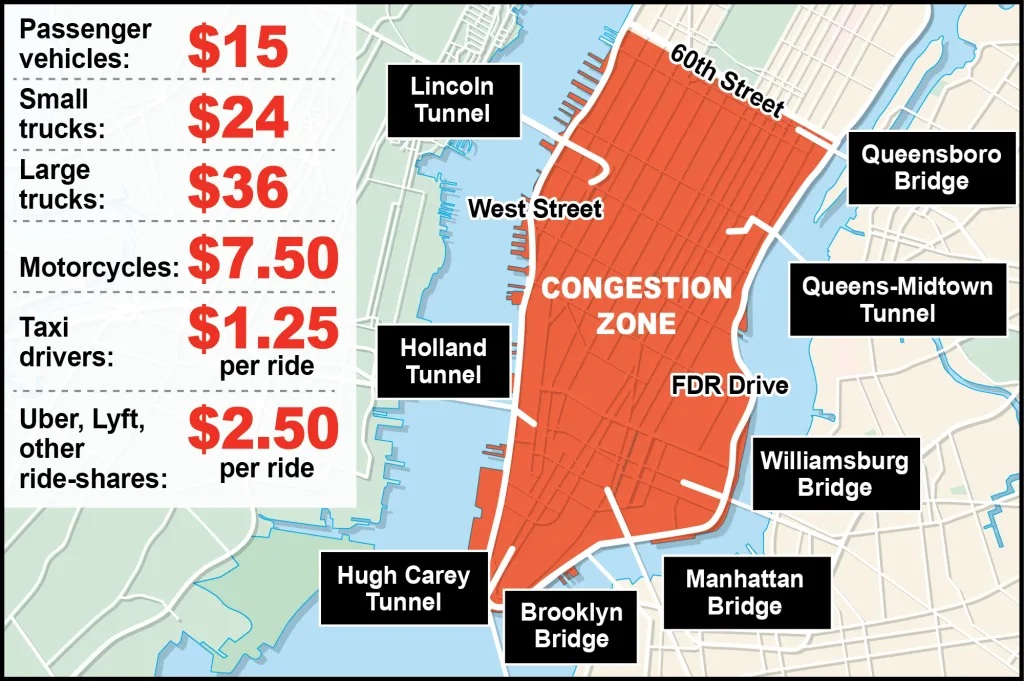
New York City – The long-anticipated congestion pricing program is set to debut in New York City, making it the first city in the United States to implement such a system. Aimed at reducing traffic congestion and improving air quality, the initiative has sparked debate among residents, commuters, and businesses. Here’s an in-depth look at what congestion pricing means for the city.
What Is Congestion Pricing?
Congestion pricing is a tolling system designed to charge drivers for entering designated high-traffic zones during peak hours. In New York City, the program focuses on Manhattan’s Central Business District, defined as the area south of 60th Street.
The goal is twofold:
- Reduce Traffic: By discouraging unnecessary car trips, the plan seeks to ease gridlock in one of the busiest parts of the city.
- Fund Transit Improvements: Revenue generated from the tolls will be reinvested into public transportation infrastructure, particularly the Metropolitan Transportation Authority (MTA).
How It Works
- Toll Rates: While exact rates are still being finalized, reports suggest they could range from $9 to $23 for passenger vehicles and higher for commercial vehicles. Rates will vary based on the time of day and vehicle type.
- Technology: The system will rely on electronic tolling, with cameras and sensors installed at entry points to capture license plate information.
- Exemptions and Discounts: Certain vehicles, such as emergency vehicles and those driven by people with disabilities, may qualify for exemptions or reduced rates.
Timeline and Implementation
The program is expected to launch in late 2024 or early 2025, pending final approvals from the federal government and local agencies. The MTA has been working closely with the Federal Highway Administration (FHWA) to address environmental and logistical concerns.
Benefits of Congestion Pricing
Proponents argue that congestion pricing will deliver several benefits:
- Reduced Traffic: Studies suggest the program could cut traffic congestion in Manhattan by up to 20%.
- Cleaner Air: Fewer vehicles mean lower emissions, contributing to improved air quality and public health.
- Better Public Transit: The estimated $1 billion annual revenue will help fund subway and bus upgrades, improve accessibility, and address long-standing maintenance issues.
Concerns and Criticism
Not everyone is on board with congestion pricing. Key concerns include:
- Financial Burden: Critics argue that the tolls disproportionately impact low- and middle-income drivers who rely on their cars.
- Impact on Businesses: Some business owners worry that increased costs for deliveries and customer trips could hurt their bottom lines.
- Traffic Diversion: Residents of outer boroughs and nearby suburbs fear that congestion could shift to their neighborhoods as drivers seek to avoid the toll zone.
Public Reaction and Political Debate
The program has sparked fierce debate among New Yorkers:
- Supporters: Environmental advocates and transit users praise the plan as a necessary step toward sustainable urban living.
- Opponents: Suburban commuters, taxi and rideshare drivers, and some outer-borough politicians have voiced opposition, citing economic and logistical concerns.
Mayor Eric Adams has expressed strong support, emphasizing the need to modernize the city’s transportation system. “Congestion pricing is not just about reducing traffic—it’s about creating a city that works for everyone,” Adams said.
The Future of NYC Transportation
Congestion pricing represents a transformative step for New York City, aligning it with global counterparts like London, Stockholm, and Singapore, where similar systems have proven successful.
As implementation nears, the city faces the challenge of balancing the program’s benefits with the concerns of affected communities. Robust public outreach, clear communication, and equity-focused measures will be essential to its success.